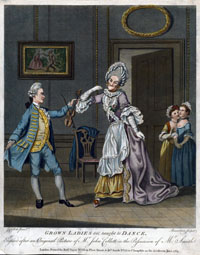Dance

Dancing served many purposes in the eighteenth-century British world. Dances (often called balls or assemblies) were occasions for meeting new people, for catching up with old friends, for courtship, and sometimes for celebrating victories or public holidays. Dance, however, was also a way to display one's wealth (by showing that he or she could afford dance instruction, leisure time to practice, and fashionable clothing), elegance of deportment, and knowledge of proper etiquette. Dancing masters or mistresses taught fashionable dance forms, as well as proper behavior. Public dance events, which anyone could attend provided one could purchase a ticket, were held in purpose-built assembly rooms, taverns, or public buildings. Private assemblies were generally held at home or in a hired public space.
In the late colonial period, dance events in America often attempted to mimic English aristocratic society by beginning with the minuet, a dance that made its first appearance in the court of Louis XIV of France in the 1660s. As one historian has described it, "the minuet was dignified, graceful, relaxed and unaffected, unlike some modern re-creations in which exaggerated postures are used." Country dances, a recognizable transplantation of British (primarily English) folk traditions, often followed the minuet. A vehicle for the sociability, country dances were usually performed in "longways" sets, that is, men in one long line opposite to a line of women, partners facing one another. Figure dances that traced their origins to entertainments set on provincial English greens, country dances could be set to any number of folk or popular music pieces. The dance began with the couple at the "head" of the set, who would dance the figures with the next couple or two couples. One of these figures would allow the first couple to progress down the set one space and begin dancing with the next couple, activating each couple in turn. The first couple danced all the way down the set and back to the head, maximizing the opportunity for conversation.
French cotillions, danced in squares, became popular in Britain and its colonies in the third quarter of the eighteenth century. They were particularly fashionable during the War for Independence, when the French were America's allies.






